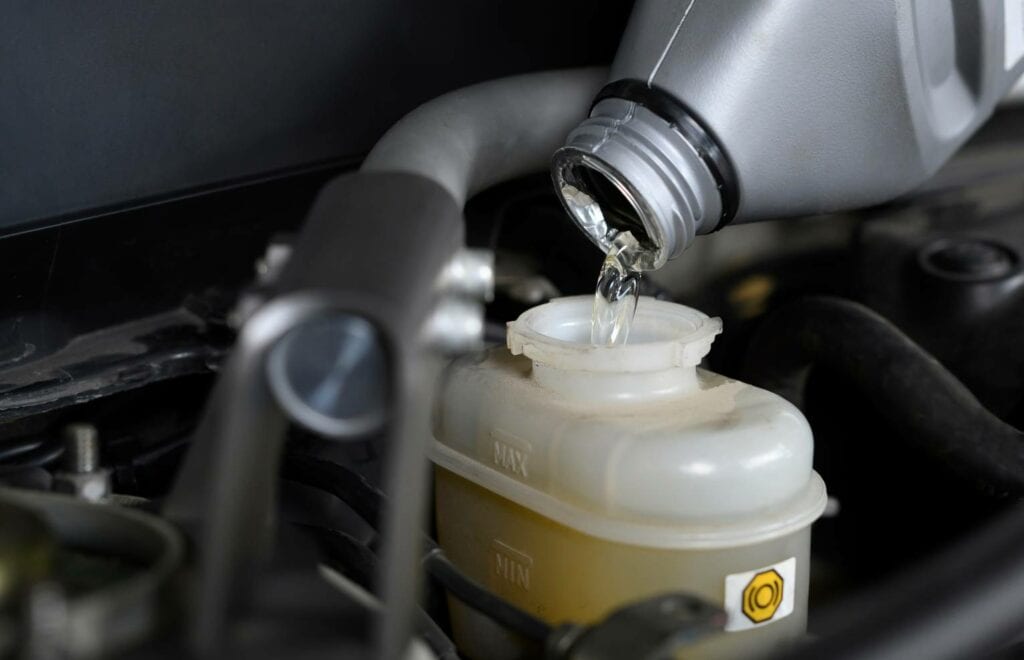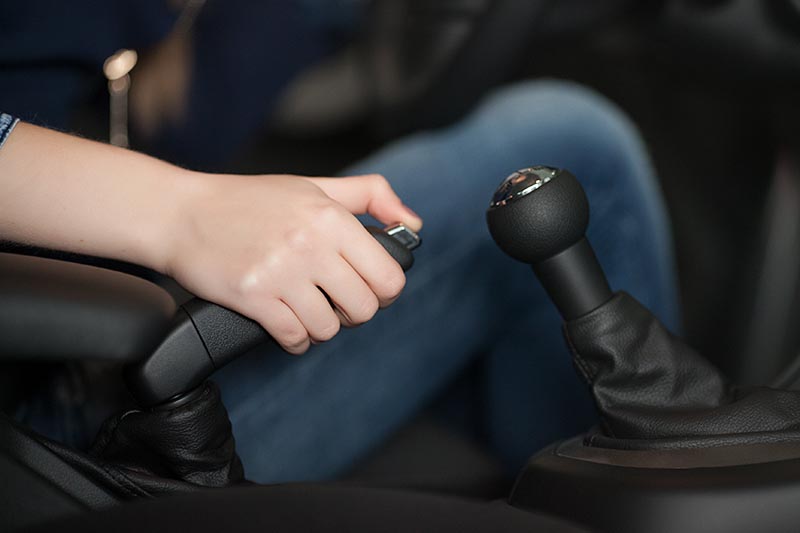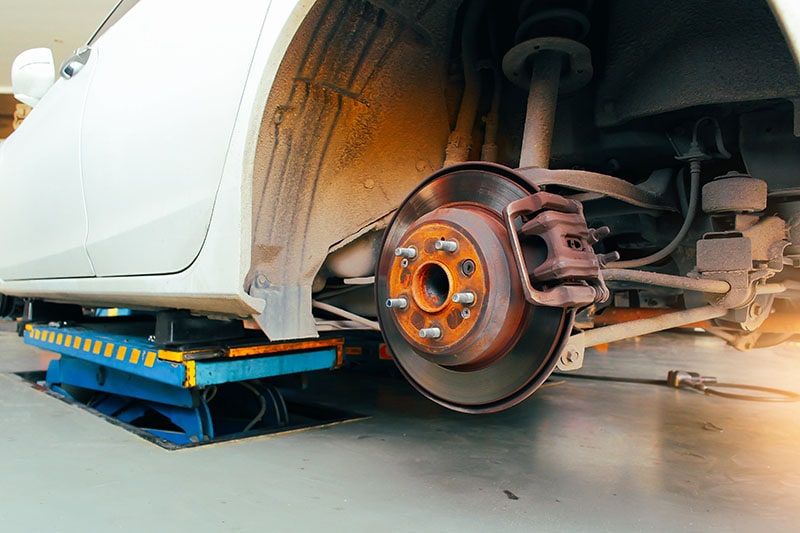How Do Car Brakes Work? Pros, Cons, & FAQ
-
Jeff Weishaupt
- Last updated:

Whenever we use the brakes of our cars, we rely on them to operate flawlessly. Unfortunately, we assume brakes are faultless mechanisms because most of us don’t know how they work. Even if you’re not a mechanic, any car owner can benefit from understanding the operation of the most crucial aspect: the brakes. Essentially, your car brakes impede motion by absorbing energy from the system.
Understanding how your car brakes work can determine when you need to get them checked and how to care for them properly. Keep reading to learn the complete operation of car brakes, their types, pros, and cons.
 How Do Car Brakes Work?
How Do Car Brakes Work?
Most modern cars have dedicated brakes for all four wheels operating on a hydraulic system. However, it’s important to note that the brakes dedicated to the front wheels are more crucial than those on the rear wheels.
That’s because as the brakes slow down the wheels, the vehicle’s entire weight is propelled toward its front. This is precisely what makes disc brakes so efficient for the front wheels, while drum brakes work best on rear wheels.
Unfortunately, you’ll find all-disc brake systems in most low-cost vehicles. Still, the operation of all brake types is undoubtedly fascinating. Drivers are able to stop a machine weighing thousands of pounds just by stepping on a pedal.
When the driver’s foot depresses the brake pedal, the force is directly transmitted to the brakes in the form of a fluid. But, of course, simply the weight of the driver’s foot isn’t enough to activate the brakes.
That is why the system multiplies this force with the help of mechanical advantage or hydraulic force. Once the brakes receive sufficient force, they send it to the brakes in the form of friction. Then, the tires use this friction to send further force to the road surface.

Hydraulics
Most modern cars include two hydraulic circuits and two master cylinders. These components guarantee the safe and timely operation of each other, with one activating if the other fails. In some cases, the circuit will function the brakes on the front wheels, and the cylinders will operate the rear brakes.
Some brake systems are even specifically designed to allow single circuits to operate all dedicated brakes. If the driver opts for heavy braking, most of the vehicle’s weight will be relieved from the rear wheels while wheel locking.
Unfortunately, this can risk the driver’s life by causing a dangerous skid. This is why rear brakes are intentionally manufactured to be less controlling and powerful than the brakes on the front wheels.
Most modern cars feature a pressure-limiting, load-sensitive valve, which closes whenever the driver applies heavy braking. Since heavy braking raises the hydraulic pressure enough to lock the rear wheels, it prevents the fluid from flowing to them.
Luckily, all modern vehicles are equipped with complex and efficient anti-locking brake systems. These systems activate and deactivate the brakes rapidly and repeatedly, preventing them from locking dangerously.
Friction
We all know that friction, in enough quantity, can prevent an object from moving over a surface or another object. So, of course, friction is crucial for the operation of all car brakes. The amount of force required to move an object is directly proportional to its weight. The heavier it is, the more force will be required to create enough friction to stop it.
When it comes to car brakes, pressing the brake pad against the brake disc creates the necessary friction. The more force you send to the brake pad, the quicker you can stop the car. The amount of required force can be determined by the coefficient of static friction (μ = F/N). However, regarding car tires, the coefficient of dynamic friction is much less potent than the coefficient of static friction.
As a result, the tires create the most friction when the point of contact doesn’t move along with the road surface. This friction reduces drastically when the car skids or slides. The distance between the brake pivot and the brake pedal is also worth noting.
If this distance is four times as long as the one between the pivot and the cylinder, the force on the brake pedal must rise four times than before it traveled to the cylinder. This is because the diameter of the brake cylinder is also three times that of the pedal cylinder.
This difference in diameter contributes to the force multiplication, increasing brake power. For example, if the force is increased nine times, the braking system will multiply the force of the driver’s foot 36 times.
So, if the driver puts 12 pounds of force onto the brake pedal, the system will generate an overall 432 pounds of force to stop the car.

Brake Fluid
A hydraulic fluid for transferring force to the brake system, brake fluid plays a crucial role in the entire process. It creates sufficient pressure to enhance the braking force. If the brake fluid is leaking slowly, it can lead to insufficient fluid required to fill the brake cylinder.
This can cause issues with the brakes’ operation. On the other hand, if the brake fluid is leaking rapidly and significantly, the first time the driver presses the brake will cause further leaks. As a result, the car may suffer from total brake failure. Luckily, modern vehicles are equipped with master cylinders to rectify such problems.
What Are the Different Types of Car Brakes?
There are various types and subtypes of car brakes, with the most prominent ones being frictional, pumping, and electromagnetic brakes. Frictional brakes are the most common kind, including its subtypes: disc brakes and drum brakes.
Frictional Brakes
Frictional brakes are the most popular brake type, with its subtypes including show and pad brakes. These types rely on an explicit wear surface. Meanwhile, the third type of frictional brakes, hydrodynamic brakes, do not wear explicitly and rely on friction in working fluids.
However, friction brakes typically entail pad and show brakes, not hydrodynamic ones, even though they are a type of friction brakes. Pad and shoe brakes utilize a rotation system, stationary pads, and rotating wear surfaces.
In standard configurations of this system, you’ll find a contracting shoe that rubs the rotating drum’s exterior. This rotating drum may be a banded drake with an expanding show rubbing the drum’s interior, also known as a drum brake.
This drum brake uses a set of brake shoes to press the rotating drum’s interior to cause friction. In this system, the drum connects to a rotating roadwheel’s hub. Such brakes are typically equipped in older truck and car models.
Since these brakes are comparably cheaper to produce, you may also find them equipped in the rear wheels of more affordable modern vehicles. However, their affordability is overshadowed by their quick wear and tear due to overheating, especially in comparison to modern disc brakes.
Contrastingly, the disc brake is manufactured with ceramic or cast iron and attached to the axle or wheel. The brake pads act as friction material is forced against both sides of the disc to stop the wheel from turning.
These pads are placed in the brake caliper, and the process is done either electromagnetically, pneumatically, hydraulically, or mechanically. As a result, enough friction is produced to stop the attached wheel and disc.
Pumping Brakes
Pumping brakes are only equipped in cars where a pump is already included in the system. For example, internal-combustion piston motors can completely stop the fuel supply. As a result, the internal pumping losses within the engine cause the car to brake.
In some cases, the engine may rely on valve override, known as the Jake brake, to increase the number of pumping losses. Additionally, pumping brakes may discard energy in the form of heat or recharge its pressure reservoir, also known as the hydraulic accumulator.

Electromagnetic Brakes
Electromagnetic brakes are only equipped in cars with an electronic motor already included in the system. For example, modern hybrid gasoline and electric cars count on electric motors to generate a charge for the electric batteries.
This electric motor may also serve as a regenerative brake. Some diesel or electric railroad engines may even use it to generate electricity for the resistor bank. Later, the generated electricity will be discarded in the form of heat.
Overall, friction brakes apply force on both objects separately to slow and stop the car in a controlled manner.
 Advantages of Car Brakes
Advantages of Car Brakes
Of course, car brakes have endless and obvious advantages. They help drivers stop their cars when needed and prevent the wheels from locking when the car is skidding or sliding.
More specifically, disc brakes manage heat better than other brake types, resulting in lesser brake fade. Overall, drivers using disc brakes can benefit from a more consistent braking performance.
Additionally, these brakes perform much better in wet conditions, especially compared to other brake types. In this brake system, the rotor resists water while the brake pads wipe it every time it comes in contact with moisture. As a result, disc brakes can perform better in wet conditions compared to drum brakes.
Additionally, disc brakes prevent wheel-locking better than most brake types, excluding anti-lock braking systems. Their operation is much more straightforward and linear in comparison to drum brakes, which is why drivers can count on them to prevent wheel locking during heavy braking.

Disadvantages of Car Brakes
Most car brake systems are efficient, but certain types have their vulnerabilities. For example, drum brakes don’t dissipate heat as well as other types. This system requires quite a lot of friction to stop the car, resulting in too much heat.
With repeated use, these brakes get hotter and hotter, lowering their efficiency every time. This repetitive heating can also make them vulnerable to brake fades. Additionally, drum brakes are not effective in wet conditions.
If your car is passing through water, moisture may pool within the drum brakes, which can negatively influence the braking performance.
 Frequently Asked Questions (FAQs)
Frequently Asked Questions (FAQs)
What Is a Mechanical Handbrake?
Mechanical hand brakes utilize the car’s shoes in an intricate mechanism for proper functioning. This system differs from the hydraulic cylinder significantly since it’s equipped with a level and arm inside the brake drum.
Additionally, it operates with the help of a cable from the handbrake’s lever, which applies brake force to the car’s rear wheels. The mechanical handbrake allows the driver to brake if the hydraulic system stops working.
How Does an Anti-Lock Braking System Work?
Anti-lock brakes are one of the most efficient brake types, which is why they’re mandated in most countries. This system is beneficial when the driver brakes harshly and quickly, which may cause the wheels to lock and risk the driver’s life.
An anti-lock braking system can prevent wheel locking by reducing and increasing the brake pressure rapidly and repeatedly. As a result, the wheels keep moving as the car slows to a stop, preventing dangerous wheel locking.

Which Brakes Are the Most Affordable?
Drum brakes are the least expensive type of brakes, which is why cars equipped with these brakes are also more affordable. However, it’s also worth noting that cars with dedicated disc brakes for all wheels are more expensive than those with drum brakes on the rear and disc brakes on the front wheels.
Additionally, drum brakes are more economical to maintain and can have a surprisingly long lifespan. You can expect them to last 200,000 miles. Meanwhile, disc brakes are the more expensive option but last no more than 50,000 miles.
 Conclusion
Conclusion
Taking care of your car can be impossible if you don’t understand its central mechanisms, including the brakes. Now that you know how car brakes operate and their various types, you can guarantee proper brake maintenance and care.
Featured Image Credit: Pixabay
Contents
 How Do Car Brakes Work?
How Do Car Brakes Work? Advantages of Car Brakes
Advantages of Car Brakes Frequently Asked Questions (FAQs)
Frequently Asked Questions (FAQs)